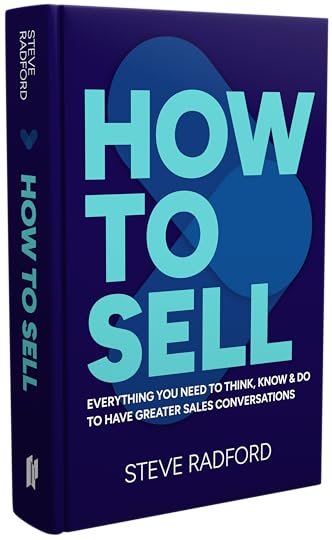Why Human Skills Still Win in the Age of AI
This blog brought to you by The Sales Hunter Podcast, Episode #350 with special guest, Steve Radford.
The Marketplace has changed—have you?
The way we sell has changed dramatically. Technology is reshaping conversations, and buyers no longer respond the way they used to.
Mark Hunter, host of The Sales Hunter Podcast, sat down with UK-based sales expert Steve Radford, author of the upcoming book How to Sell, to explore what great selling looks like in today’s market.
AI Is Powerful—But It’s Weak at Being HumanAI is transforming the sales process, and that’s both good and bad news. As Radford explained, “AI is a fantastic tool, but it’s leading to an erosion of conversational selling skills.”
Sales professionals now rely heavily on AI to research, generate proposals, and even automate follow-ups. The problem? Many are losing the ability to connect live with prospects. Sales has always been a conversation between people, and that’s a skill AI can’t replicate.
Use AI to Prepare—Not to SellRadford encourages sales teams to use AI wisely. It’s excellent for preparation—researching prospects, building discovery questions, or running training simulations. But when the live conversation begins, AI should go silent.
“Person to person,” Radford says, “AI should be off. Rely on your human-centric selling skills.”
Practice Before You PlayOne of the most overlooked benefits of AI is using it to practice. Radford points out that professional athletes spend far more time training than performing—but salespeople rarely rehearse.
Now, AI tools make it easy to role play with simulated buyers, helping sellers refine their skills before the real call. “Salespeople never practice enough,” Radford says. “And yet, practice is where confidence and competence are built.”
The Seven-Step Sales ProcessAt the core of Radford’s new book is a seven-step sales methodology designed to align with how customers like to buy—not how salespeople like to sell.
Plan & Prepare – Know your market and your customer before the call.Engage – Open the conversation and establish rapport.Understand – Go deeper than “discovery.” Understand the person, not just the problem.Propose & Present – Recommend the right solution or next step.Trial Close – Test the waters with a question like, “How does that sound?”Close – Finalize the agreement or commitment.Follow Up – Reflect, learn, and improve your next conversation.Objection handling and negotiation sit outside the main pathway. As Radford explains, “Your goal should be to propose a solution so good that the customer accepts it without objections.”
From Discovery to UnderstandingRadford intentionally replaces the word discovery with understanding. Why? Because discovery often turns into a checklist.
“Understanding means going beyond the facts,” he says. “It’s about what lies behind the customer’s answers—their motivations, personal goals, and values.” Even in B2B sales, the buyer has personal KPIs and emotional drivers. Understanding those creates real connection.
The Conversation FunnelTo guide the understanding phase, Radford uses a conversation funnel:
Start with broad, open questions to invite dialogue.Move to probing questions (“Tell me,” “Explain to me,” “Describe to me”) to explore deeper.Finish with closed questions to clarify what you’ve heard.This approach ensures you don’t lead the customer too soon—and you may discover insights that reshape the entire sales process.
Stay on the Buyer’s JourneyMany salespeople make the mistake of centering the pitch on their product instead of the buyer. Radford advises limiting your presentation to three key points, each tied to the buyer’s language and priorities.
“When you use the customer’s own words to justify your recommendation,” he says, “you’re asking them to agree with themselves.”
Features, Advantages, and Benefits—FastRadford teaches the Feature → Advantage → Benefit model, but with a twist: move through it quickly.
A feature is what something has.
An advantage is why it exists.
A benefit is why it matters to the buyer.
“If you can do that in two or three sentences,” he says, “you’re selling effectively.”
Close the Loop: Follow Up with PurposeStep seven—Follow Up—isn’t just administrative. It’s about reflection and growth.
Radford describes two dimensions:
This closes the loop, turning each sales experience into a learning opportunity.
The Right Mindset: Win-Win SellingIn How to Sell, Radford begins not with tactics but with mindset. The most important is the win-win mindset—selling with the goal of helping customers achieve outcomes that are good for both sides.
“It’s not about ethical selling for the sake of ethics,” he says. “It’s the most effective way to sell long-term.” This mindset turns buyers into what Radford calls “zombie loyalists”—customers so satisfied that they keep coming back and referring others.
Sales Is About Helping PeopleRadford reminds us that every great sale starts with a simple mission: help the customer. When salespeople focus on that goal, confidence rises, and pressure falls. As he puts it, “Let’s just go help this customer if we can.”
It’s the foundation of modern selling—powered by empathy, strengthened by preparation, and supported (but never replaced) by technology.
Learn MoreSteve Radford’s book How to Sell: Everything You Need to Think, Know and Do to Have Greater Sales Conversations launches November 25. Early sign-ups at greaterSales.com/howtosell receive a free chapter, exclusive bonuses, and a launch-day discount.
 Want to have greater sales conversations?
Want to have greater sales conversations?Join the pre-launch of Steve’s new book here.

Mark Hunter's Blog
- Mark Hunter's profile
- 25 followers



